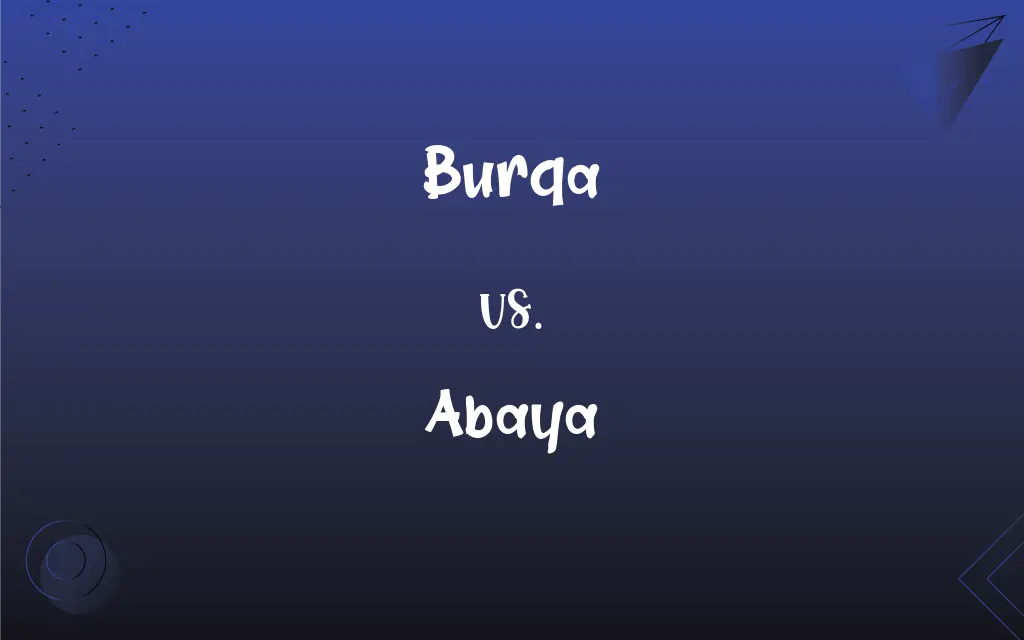Burqa vs. Abaya: What's the Difference?
Edited by Aimie Carlson || By Harlon Moss || Published on January 30, 2024
A burqa is a full-body veil with a mesh screen over the eyes; an abaya is a loose, flowing robe worn over clothes, typically without covering the face.

Key Differences
The burqa is a full-body covering, including a face veil with a mesh screen for the eyes, traditionally worn in some Islamic cultures. The abaya, on the other hand, is a long, flowing robe that covers the body but not necessarily the head or face, commonly worn in many Middle Eastern countries.
In some regions, the burqa symbolizes modesty and religious adherence, covering the entire body to maintain privacy. The abaya, while also a symbol of modesty, is more a cultural garment, providing coverage yet offering more freedom in terms of head and face exposure.
Burqas are often uniform in style, typically in blue or black, with few variations. Abayas, however, come in various styles, colors, and designs, allowing for a degree of personal expression while maintaining the principle of modesty.
The burqa provides complete privacy and modesty, often worn in regions with strict dress codes for women. Abayas, being more versatile, are widely used in both casual and formal settings, easily adaptable to different social situations.
The burqa is more prevalent in countries like Afghanistan and parts of Pakistan, closely tied to local customs. Abayas are widely worn in the Arabian Peninsula, including countries like Saudi Arabia and the UAE, reflecting a broader regional dress style.
ADVERTISEMENT
Comparison Chart
Body Coverage
Covers the entire body, including face and eyes.
Covers the body, often leaving the head and face uncovered.
Cultural Association
Strongly associated with certain Islamic practices.
More broadly worn in many Islamic cultures.
Design Variation
Generally uniform in style.
Offers a variety of styles and colors.
Face Visibility
Includes a mesh screen over the eyes.
Does not typically cover the face.
Regional Usage
Common in Afghanistan, parts of Pakistan.
Widely used in the Arabian Peninsula and Middle East.
ADVERTISEMENT
Burqa and Abaya Definitions
Burqa
Cultural Garment.
In her community, the burqa symbolized tradition and modesty.
Abaya
Modesty Attire.
Her abaya allowed her to dress modestly and fashionably.
Burqa
Full-Body Veil.
Wearing a burqa in the marketplace, she felt a sense of privacy.
Abaya
Flowing Robe.
Dressed in an abaya, she attended the evening event with elegance.
Burqa
Religious Attire.
For her, the burqa was an expression of religious devotion.
Abaya
Versatile Garment.
She wore her colorful abaya both to work and social gatherings.
Burqa
Privacy Clothing.
She chose a burqa for complete privacy in public spaces.
Abaya
Elegant Outerwear.
The abaya added an element of grace to her outfit.
Burqa
Traditional Dress.
The burqa, a traditional dress, was part of her heritage.
Abaya
Cultural Dress.
Wearing an abaya was a part of her cultural identity.
Burqa
A loose, usually black or light blue outer garment worn by Muslim women that covers the head and face and sometimes the entire body.
Abaya
A loose robe worn by Muslim women, especially in Arabic-speaking regions, covering the body from head to toe or the neck down and often worn with a headscarf and veil. Also called aba.
Burqa
Alternative spelling of burka.
Abaya
Synonym of aba
Burqa
A loose garment (usually with veiled holes for the eyes) worn by Muslim women especially in India and Pakistan;
The Taliban forced all women to wear the burqa
Abaya
(Arabic) a loose black robe from head to toe; traditionally worn by Muslim women
FAQs
Where is the burqa commonly worn?
Predominantly in Afghanistan and some parts of Pakistan.
Does the burqa cover the face?
Yes, it covers the entire face except for the eyes, which are visible through a mesh.
What is a burqa?
A full-body veil covering the entire body and face, with a mesh screen over the eyes.
Can abayas be stylish?
Yes, they come in various styles, colors, and designs.
Is the abaya a religious garment?
It's more cultural than religious, reflecting modesty in dress.
What is an abaya?
A long, flowing robe that covers the body, typically worn over clothes.
How does one see through a burqa?
Through a mesh or net screen over the eyes.
Is the abaya limited to black color?
No, abayas are available in many colors and designs.
Can non-Muslims wear an abaya?
Yes, there's no religious restriction on who can wear an abaya.
Can the burqa be colorful?
Traditionally, they are blue or black, but variations exist.
Can abayas be custom-made?
Yes, many designers create custom abayas.
Are abayas worn in Western countries?
Yes, they are worn by some Muslim women in Western countries as well.
Do abayas come in different lengths?
Yes, they vary in length to suit different preferences.
Is the abaya a formal dress?
It can be, depending on the style and occasion.
Is it mandatory to wear a burqa in some countries?
In certain regions, cultural and religious norms make it customary, sometimes mandatory.
Are burqas worn for specific occasions?
Generally, they are worn as daily attire in certain cultures.
How is the burqa different from a niqab?
A niqab covers the face except for the eyes, without the full-body covering.
What fabric is used for abayas?
Typically lightweight fabrics like crepe, chiffon, or silk.
Is the burqa only worn by older women?
No, it's worn by women of various ages, depending on cultural norms.
What is the significance of wearing a burqa?
It varies, ranging from cultural tradition to personal choice for modesty.
About Author
Written by
Harlon MossHarlon is a seasoned quality moderator and accomplished content writer for Difference Wiki. An alumnus of the prestigious University of California, he earned his degree in Computer Science. Leveraging his academic background, Harlon brings a meticulous and informed perspective to his work, ensuring content accuracy and excellence.
Edited by
Aimie CarlsonAimie Carlson, holding a master's degree in English literature, is a fervent English language enthusiast. She lends her writing talents to Difference Wiki, a prominent website that specializes in comparisons, offering readers insightful analyses that both captivate and inform.































































